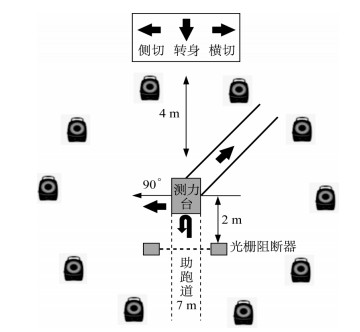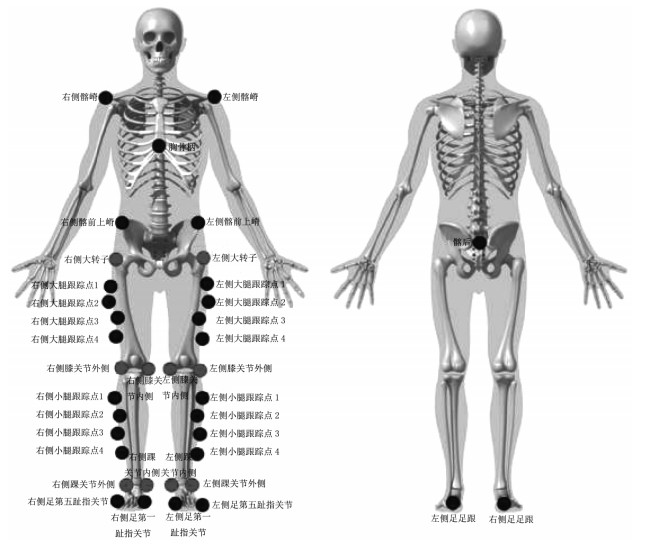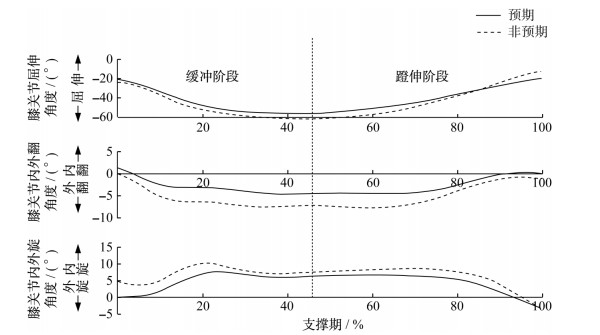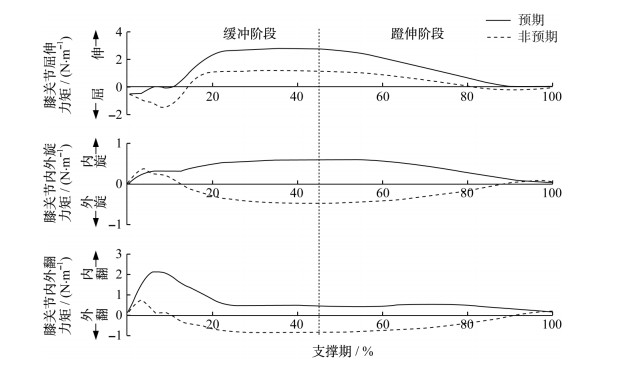Sports Biomechanics Characteristic of Knee Joint During Sidestep-cutting Maneuver among Female Football Players on Unanticipated Condition
-
摘要: 为了了解非预期条件下女足运动员侧切动作中膝关节运动生物力学特征的变化及其带来的膝关节前交叉韧带(ACL)损伤风险,采用Vicon运动捕捉系统和Kistler三维测力台采集预期条件下和非预期条件下的女足运动员侧切动作时的下肢三维运动学和动力学参数;采用配对样本t检验对膝关节的角度、力矩、侧切力峰值等指标进行统计分析。结果显示:①预期条件下,触地时膝关节处于内翻状态,而非预期条件下则处于外翻状态;②非预期条件下,膝关节最大屈曲角度、最大外翻角度、最大内旋角度显著大于预期条件下的角度(P < 0.05);③非预期条件下,膝关节主要受到外翻和外旋力矩的作用,预期条件下主要受到内翻和内旋力矩的作用;④非预期条件下,侧向地面反作用力明显大于预期条件下的反作用力(P < 0.05)。由此可知:非预期条件下侧切动作在触地时刻的膝关节外翻姿态以及在缓冲阶段的更多外翻和内旋表现,可能是导致侧切过程中地面反作用力增大和膝关节力矩载荷性质转变的主要力学机制,说明非预期的侧切动作可能会增大ACL损伤发生的风险。Abstract: The purpose of this study was to investigate the effects of unanticipated condition on knee joint biomechanics, and to discover the potential risk of ACL injuries during sidestep-cutting among female football players. Methods:Female football players were recruited in this study. Participants were asked to perform the sidestep-cutting technique during anticipated and unanticipated conditions. Kinematics data was recorded by Vicon and kinetic data was recorded by one force plate (Kistler). Knee joint angles, moments, and lateral Ground Reaction Force (GRI) were analyzed. Paired t-test was performed to compare the kinematics and kinetics variables between anticipated and unanticipated conditions. Results:1) Knee joint was varus in anticipated condition, while was at valgus in unanticipated condition. 2) Maximum knee flexion angle, maximum knee valgus angle and maximum knee internal rotation angle were bigger in unanticipated condition, compared with anticipated condition during sidestep-cutting (P < 0.05). 3) The main effect was from valgus and external rotation moment in unanticipated condition while it was from varus and internal rotation moment in anticipated condition. 4) The lateral GRI in unanticipated condition was lager than the anticipated condition (P < 0.05). Conclusion:Compared with anticipate condition, the valgus status of knee joint and bigger valgus and internal rotation angle of knee joint at buffer phase might be the major biomechanics mechanism of bigger ground reaction force and natural transition of knee moment at unanticipated condition during side cutting. It indicated that side cutting movement might increase the risk of ACL injury at unanticipated condition.
-
快速变向能力是优秀足球运动员必备的专项技术,在比赛中可以有效地摆脱对手。据统计,每一场正式的足球比赛中,人均变向动作多达700余次,且多为90°左右的大幅度变向动作[1],其侧切动作(sidestep-cutting)是快速变向动作中最为常用的技术之一。因此,侧切动作一直是足球技术研究的重点,而与侧切动作有关的运动损伤问题则是其中的一个热点话题。有大量研究发现,侧切动作与足球运动员常见的膝关节前交叉韧带(anterior cruciate ligament,ACL)损伤有密切联系,70%以上的ACL损伤出现在急速的侧切动作中[2-3],且女子足球运动员ACL损伤的概率远高于男性,约为男子的2~3倍[4-5]。
传统上对跳跃-落地、侧切等动作中的ACL损伤风险因素的研究多采用预期试验模式进行,即在受试者有准备的状态下,来完成指定动作(落地、侧切或2者结合),然后分析动作当中的下肢运动特点[6-8]。然而,这种预期条件下的测试并不能完全真实地反映运动员在比赛环境中的实际情况。足球比赛中,运动员经常面对外界的突然变化做出快速的反应,如为摆脱对手瞬间变向,或为接队友来球突然动作,这些外来刺激都是在不确定或非预期(unanticipated)条件下发生的。因此,与预期条件下的测试相比,非预期条件下的测试可以更好地模拟比赛环境的实际情况(非预期条件是指受试者预先不知道测试动作的方向或者路线,而需通过视觉预判做出临时反应)[9]。
然而,目前大部分关于女子足球运动员的运动损伤问题研究是在预期条件下分析侧切或急停起跳等动作时对膝关节的生物力学影响,只有少数研究对比了预期与非预期条件下的45°侧切动作,发现非预期条件下完成45°侧切动作时由于膝关节的外翻角度、外翻力矩及内旋力矩的增加,膝关节需承载负荷更大,导致非接触性ACL损伤的风险可能增大[10-12]。除45°侧切动作外,90°及更大角度的侧切动作在实际足球比赛中的采用也十分频繁,由于动作幅度更大,膝关节有着更高的ACL损伤发生风险。
由于非预期条件下完成大角度(≥90°)侧切动作时的膝关节运动及受力特点目前尚不明确,因此,本文目的在于比较女子足球运动员预期和非预期2种条件下,完成90°侧切动作过程中膝关节运动学及动力学方面的异同,尝试了解非预期条件下女子足球运动员膝关节ACL损伤潜在的风险,以期为相关的变向技术动作提供数据与理论支撑。
1. 研究对象与方法
本文关于女子足球运动员完成侧切动作时的假设如下:①完成90°侧切动作时,非预期条件与预期条件下,触地时刻膝关节着地状态不同;②与预期条件相比,缓冲阶段非预期条件下膝关节屈曲角度变小,外翻角度和力矩增大;③与预期条件相比,非预期条件下膝关节承受的负荷更大,并增加ACL损伤发生风险。
1.1 研究对象
本文招募21名大学女子足球运动员,要求为受试者在过去1年中无下肢损伤,且自愿参与本项目测试。招募的受试者情况:年龄(18.4 ± 1.4)岁,身高(166.0 ± 5.2)cm,体质量(60.1 ± 5.5)kg;已训练年限约为10年;其中,运动水平达到国家健将的2名,达到一级的16名,达到二级的3名。在测试开始前,告知所有受试者测试内容,征得其同意后签署知情同意书。
1.2 测试方案
1.2.1 测试仪器
测试仪器包括三维红外运动捕捉系统、三维测力台及红外光栅阻断设备。
(1)三维红外运动捕捉系统。采用16台三维红外摄像头(T40)和英国产运动捕捉系统(vicon motion analysis),配套直径14 mm的反光标志球,用于采集膝关节运动学参数,采样频率为200 Hz。
(2)三维测力台。采用瑞士Kistler Instruments AG Corp.生产的三维测力台1块(90 cm×60 cm×10 cm),用于采集测试动作的动力学参数,采样频率为1 000 Hz。
(3)自制红外光栅阻断设备。基于Arduino开源电子原型平台,自主设计并加工制作红外光栅阻断器。阻断器分为红外发射器、红外接收器及转向灯3个部分,其中红外发射器和接收器分别放置在跑道两侧距离测力台中心前2 m处,转向灯屏幕放置在距测力台边缘后4 m处(图 1)。阻断器主要用于模拟测试时的非预期条件,受试者助跑经过并阻断红外线时,代表 3个不同动作的转向灯会随机亮起,提示受试者依据视觉判断来完成测试动作。
1.2.2 测试流程
为了使实验室条件下的非预期侧切动作指令更加符合足球运动中的“非预期”实际情况,本文在非预期条件的设计上混杂了侧切90°(优势腿触地后,向优势腿对侧90°转向)、横切45°(优势腿触地后,向优势腿同侧45°转向)、转身180°(优势腿触地后,向后180°转向)这3个足球比赛中最为见的变向动作,运动员在跑步过程中需根据转向灯的随机指令来完成相应的变向动作,使得随机完成的侧切动作在理论上满足非预期假设。
测试前,要求所有受试者进行10 min慢跑热身及3 min拉伸练习,身着测试服饰(背心、短裤、鞋和袜子),确定优势腿[13](惯用踢球腿,本文受试者优势腿均为右腿)。38个直径14 mm的反光标志求球放置在受试者骨盆及下肢的骨性标志点上(见图 2)。测试前向受试者说明测试流程、测试动作及注意事项,并留出时间给受试者熟悉3种变向动作。
正式测试时,要求每名受试者在长7 m的场地上(图 1)全速助跑,完成预期和非预期2种条件下的测试。预期条件下按指令只完成90°侧切动作;非预期条件下,受试者助跑通过红外线阻断设备后,需根据转向灯的指示方向完成变向动作,要分别完成随机侧切、横切、转身动作各5次。测试要求受试者快速完成测试动作,助跑速度需≥3 m/s。,本文对预期和非预期条件下的测试结果各选3次有效的侧切动作数据进行分析。鉴于本文主要关注的动作为侧切,因此横切与转身动作的测试数据不进入分析流程。
1.3 数据处理
将侧切动作过程定义为从支撑足着地(测力台)至支撑足离地。着地与离地的判断标准为:地面反作用力垂直分量≥10 N即为着地,≤10 N则为离地。根据肌肉的工作性质,整个侧切动作又可分为缓冲阶段与蹬伸阶段:缓冲阶段从支撑足着地至膝关节最大屈(膝关节伸肌离心收缩),蹬伸阶段从膝关节最大屈至支撑足离地(膝关节伸肌向心收缩)。将捕捉得到的运动学和动力学原始数据导入Visual 3D分析软件,采用Butterworth四阶低通滤波器对原始运动学和动力学数据进行滤波平滑,截止频率分别为设为12 Hz和100 Hz[14]。
选取指标:膝关节在助跑速度(采用着地瞬间的重心水平速度)、触地时刻及缓冲阶段这3个运动平面中的角度值;缓冲阶段垂直地面反作用力峰值;侧向地面反作用力峰值;膝关节角度和力矩峰值及其时间曲线。
1.4 统计学分析
所得结果采用“均值±标准差”表示,并采用配对样本t检验观察2种条件下侧切动作时膝关节的运动学和动力学差异,显著性水平设定为P < 0.05。统计软件采用SPSS19.0。
2. 研究结果
2.1 预期/非预期条件下助跑速度
测试者以最快速度助跑,非预期条件下助跑速度(3.01±0.27)m/s明显小于预期条件下助跑速度(3.39±0.35)m/s(P < 0.05)。
2.2 预期/非预期条件下运动学指标
如图 3所示,在整个侧切动作过程中,预期和非预期2种条件下膝关节额状面基本均处于外翻状态,水平面处于内旋状态,矢状面处于屈曲状态,二者的角度变化趋势基本一致。但相比于预期条件,非预期条件下各角度均有所增大。
如表 1所示,触地时刻,非预期条件下最大膝屈角度和内旋角度均显著大于预期条件下的角度(P < 0.05);非预期条件下膝关节处于外翻状态(角度为-0.17°±4.23°);而预期条件下膝关节呈内翻状态(角度1.30°±4.31°)。
表 1 触地时刻膝关节最大角度Table 1. Peak angles of knee joint in sagittal, frontal, transverse plane at initial contact变量 预期 非预期 P 最大膝屈角/(°) -21.22±5.90 -23.75±4.76 0.038 最大内/外翻角/(°) 1.30±4.31 -0.17±4.23 — 最大内/外旋角/(°) 0.03±8.18 4.75±8.78 0.003 如表 2所示,缓冲阶段,非预期条件下最大膝屈角显著大于预期条件下的角度(P < 0.05);非预期条件下最大外翻角度和内旋角度显著大于预期条件下的角度(P < 0.05);而预期条件下最大内翻角度大于非预期条件下的角度(P < 0.05)。
表 2 缓冲阶段矢状面、额状面、水平面膝关节最大角度Table 2. Peak angles of knee joint in sagittal, frontal, transverse plane at buffer phase变量 预期 非预期 P 最大膝屈角/(°) -57.65±7.86 -62.91±4.35 < 0.001 最大内翻角/(°) 3.02±3.17 1.50±3.36 0.009 最大外翻角/(°) -7.19±4.43 -10.07±4.31 0.001 最大内旋角/(°) 10.88±5.53 13.36±5.69 0.013 2.3 预期/非预期条件下动力学指标
如表 3所示,缓冲阶段非预期条件下垂直地面反作用力显著小于预期条件下的反作用力(P < 0.05);而非预期条件下侧向地面反作用力显著大于预期条件下的反作用力。
表 3 缓冲阶段地面反作用力峰值Table 3. Peak ground reaction force at buffer phase变量 预期 非预期 P 垂直地面BW/倍 2.91±0.56 2.65±0.35 0.017 侧向地面BW/倍 0.84±0.22 0.94±0.18 0.001 注:BW表示地面反作用力达到体重的倍数。 如图 4所示,侧切动作过程的前10%阶段,预期和非预期2种条件下,膝关节均受到内翻力矩和内旋力矩的作用,但预期条件下的内翻力矩大于非预期条件下的力矩;在之后的部分缓冲和蹬伸阶段,非预期条件下膝关节受到外翻力矩和外旋力矩的作用,而在预期条件下则受到内翻力矩和内旋力矩的作用,2种条件下膝关节额状面和水平面上所受的力矩有着本质上的差异。
3. 讨论
本文主要目的在于比较女子足球运动员在预期和非预期条件下,完成90°侧切动作过程中膝关节运动学、动力学指标之间的差异,以了解非预期条件下膝关节发生非接触性ACL损伤的潜在风险。
研究结果发现,非预期条件下触地时刻膝关节处于外翻状态,而预期条件下膝关节呈内翻状态,非预期条件下缓冲阶段膝关节最大外翻、内旋角度都明显大于预期条件下的角度。造成这些结果的原因,可能是由于非预期条件下存在对动作方向的视觉预判,受试者需在极短的时间内进行姿势调整。有研究认为在这种条件下,只有利用脚外翻着地以及靠身体向外倾斜来完成触地时的启动[15],进而增加了膝关节的外翻角度和内旋角度。而预期条件下,受试者不需要先对动作方向进行视觉预判,在触地前有较充分的准备时间,能改变神经反射性反应并进行姿势调整,使身体保持一种合适的启动姿势[15-17],因此不需要额外改变膝关节的内/外翻和内/外旋角度。以上研究结果与研究假设一致,也与前人的研究结果相似。
文献[18-21]中的研究表明,女子运动员在非预期条件下,触地初期和前50%支撑期膝关节外翻角度和内旋角度增加,且非预期条件下触地时刻外翻角度远高于预期条件下。这些研究还表明80%大学女子足球运动员在做侧切动作时,缓冲阶段膝关节表现为外翻运动,且最大外翻角度增大。而膝关节最大外翻角度和内旋角度增大,可能增加了非接触性ACL损伤的发生风险。这是因为过大的膝关节外翻角度会导致韧带对膝关节的约束限制减弱,进而增加膝关节的负荷[13],并且膝关节内旋角度越大,ACL损伤越容易发生[22]。
研究结果发现,非预期条件下缓冲阶段膝关节最大屈曲角度大于预期条件下的角度,这与研究假设不一致,但与Borotikar等[23]的研究结果相一致。Borotikar等人认为在支撑期,非预期条件下侧切膝关节屈曲角度比预期条件下的角度会大。这可能是由于在非预期条件下的助跑当中,受试者需动员更多的注意资源来关注转向灯的信号刺激,以确定需完成动作的方向,这使得运动员助跑速度变慢;在接到转向灯指令时,为了加快侧切动作的完成,相比于预期条件下,受试者制动和蹬伸动作都显得不够“充分”,膝关节屈曲角度明显大于预期条件下的数值。
有研究认为,膝关节屈曲的增大限制了股四头肌发力的增加,从而使股后肌群能更有效地限制胫骨前移[24],这一结果似乎认为在非预期条件下可能会减少ACL损伤风险。然而,大量的肌肉骨骼模型研究[25]表明,单独矢状面不会产生足够使ACL损伤发生的力,且膝关节最大屈曲角度同样没有被认为是预测ACL损伤风险的指标[26]。所以,仅凭膝关节屈曲角度增大尚不能说明其降低了发生非接触性ACL损伤的风险。
研究结果发现,在缓冲阶段,非预期条件下膝关节受到外翻力矩和外旋力矩的作用,而预期条件下则受到内翻力矩和内旋力矩的作用,说明预期与非预期条件下膝关节在额状面和水平面上的受力方式有着本质区别,该结果支持了研究假设。导致这种差别的主要原因包括以下几方面:
(1)非预期条件下,膝关节触地时外翻角度大于预期条件下的角度,可能引起身体重心与足底压力中心的距离增加,进而增大地面反作用力的力臂,从而引起缓冲阶段膝关节外翻力矩的增大[27]。
(2)非预期条件下,本文增加了受试者完成侧切动作时的转向角度,以往研究中侧切动作的角度大部分是45°,而本文的侧切角度是90°。Sigward等[28]发现侧切角度增加会导致膝关节外翻力矩增加,所以动作幅度的变化也是引起了膝关节外翻力矩增大的原因。
(3)非预期条件下,受试者受到较大的侧向地面反作用力,说明在启动前运动员的身体质心远离了支撑腿,在缓冲阶段没有充分制动的情况下,触地时仓促地试图变向,这与Houck等[29]研究的一致。而预期条件下,受试者受到较小的侧向地面反作用力,说明该条件下,运动员在缓冲阶段充分制动后再进行变向。有研究表明,侧向地面反作用力是膝关节产生额状面力矩的主要原因,膝关节产生的外翻力矩随侧向地面反作用力的增大而增大[30],所以侧向地面反作用力的增加,引起了膝关节外翻力矩的增大。
(4)以往的侧切研究中发现,预期条件下运动员有着较充分的准备时间,相应的肌群产生适宜的预激活效应,可使膝关节得到有效的保护[9],但在非预期条件下,内侧肌群和伸膝肌可能没有得到充分激活,膝关节得不到肌肉收缩的保护,从而受到了外翻和外旋的作用[31]。有研究表明,侧切动作过程中增加膝关节外翻力矩是非接触性ACL损伤的主要风险因素[26]。本文中非预期条件下膝关节受到较大的外翻力矩提示该类损伤有较高的发生风险。
(5)除了外翻力矩的因素,侧向地面反作用力也是导致ACL损伤风险增加的主要因素之一。有研究表明,侧向地面反作用力越大,股四头肌力就越大,ACL承受的负载也就越大[32-33]。这从另外一个角度提示了非预期条件下发生ACL损伤风险要高于预期条件下的发生风险。
4. 结束语
与预期条件相比,非预期条件下女足运动员侧切动作在触地时刻的膝关节外翻姿态以及在缓冲阶段的更多外翻和内旋表现,可能是导致侧切过程中更大的地面反作用力和膝关节力矩载荷性质转变的主要力学机制,这提示非预期的侧切动作可能会增大非接触性ACL损伤发生的风险。
-
表 1 触地时刻膝关节最大角度
Table 1 Peak angles of knee joint in sagittal, frontal, transverse plane at initial contact
变量 预期 非预期 P 最大膝屈角/(°) -21.22±5.90 -23.75±4.76 0.038 最大内/外翻角/(°) 1.30±4.31 -0.17±4.23 — 最大内/外旋角/(°) 0.03±8.18 4.75±8.78 0.003 表 2 缓冲阶段矢状面、额状面、水平面膝关节最大角度
Table 2 Peak angles of knee joint in sagittal, frontal, transverse plane at buffer phase
变量 预期 非预期 P 最大膝屈角/(°) -57.65±7.86 -62.91±4.35 < 0.001 最大内翻角/(°) 3.02±3.17 1.50±3.36 0.009 最大外翻角/(°) -7.19±4.43 -10.07±4.31 0.001 最大内旋角/(°) 10.88±5.53 13.36±5.69 0.013 表 3 缓冲阶段地面反作用力峰值
Table 3 Peak ground reaction force at buffer phase
变量 预期 非预期 P 垂直地面BW/倍 2.91±0.56 2.65±0.35 0.017 侧向地面BW/倍 0.84±0.22 0.94±0.18 0.001 注:BW表示地面反作用力达到体重的倍数。 -
[1] BLOOMFIELD J, POLMAN R, O'DONOGHUE P. Physical demands of different positions in FA premier league soccer[J]. Journal of Sports Science & Medicine, 2007, 6(1):63-70 http://d.old.wanfangdata.com.cn/OAPaper/oai_doaj-articles_da469e9182d2cc32346ee74006ddd6cd
[2] VOSKANIAN N. ACL Injury prevention in female athletes:Review of the literature and practical considerations in implementing an ACL prevention program[J]. Current Reviews in Musculoskeletal Medicine, 2013, 6(2):158-163 doi: 10.1007/s12178-013-9158-y
[3] KROSSHAUG T, NAKAMAE A, BODEN B P, et al. Mechanisms of anterior cruciate ligament injury in basketball:Video analysis of 39 cases[J]. Orthopedics, 2007, 35(3):359-367 http://med.wanfangdata.com.cn/Paper/Detail/PeriodicalPaper_PM17092928
[4] MOSES B, ORCHARD J, ORCHARD J. Systematic review:Annual incidence of ACL injury and surgery in various populations[J]. Research in Sports Medicine, 2012, 20(3/4):157-179 doi: 10.1080/15438627.2012.680633
[5] PRODROMOS C C, HAN Y, ROGOWSKI J, et al. A meta-analysis of the incidence of anterior cruciate ligament tears as a function of gender, sport, and a knee injury-reduction regimen[J]. Arthroscopy the Journal of Arthroscopic & Related Surgery, 2007, 23(12):1320-1325 https://www.sciencedirect.com/science/article/pii/S074980630700686X
[6] BESIER T F, LLOYD D G, ACKLAND T R. Muscle activation strategies at the knee during running and cutting maneuvers[J]. Medicine and Science in Sports and Exercise, 2003, 35(1):119-127 doi: 10.1097/00005768-200301000-00019
[7] CHAPPELL J D, CREIGHTON R A, GIULIANI C, et al. Kinematics and electromyography of landing preparation in vertical stop-jump:Risks for noncontact anterior cruciate ligament injury[J]. The American Journal of Sports Medicine, 2007, 35(2):235-241 doi: 10.1177/0363546506294077
[8] MCLEAN S G, HUANG X, VAN DEN BOGERT A J. Association between lower extremity posture at contact and peak knee valgus moment during sidestepping:Implications for ACL injury[J]. Clinical Biomechanics, 2005, 20(8):863-870 doi: 10.1016/j.clinbiomech.2005.05.007
[9] BESIER T F, LLOYD D G, ACKLAND T R, et al. Anticipatory effects on knee joint loading during running and cutting maneuvers[J]. Medicine and Science in Sports and Exercise, 2001, 33(7):1176-1181 http://xueshu.baidu.com/s?wd=paperuri%3A%2817c356b1abaa8435100ef168e63260f3%29&filter=sc_long_sign&tn=SE_xueshusource_2kduw22v&sc_vurl=http%3A%2F%2Feuropepmc.org%2Fabstract%2FMED%2F11445765&ie=utf-8&sc_us=17454240135752960540&sc_as_para=sc_lib%3A
[10] MEINERZ C M, MALLOY P, GEISER C F, et al. Anticipatory effects on lower extremity neuromechanics during a cutting task[J]. Journal of Athletic Training, 2015, 50(9):905-913 doi: 10.4085/1062-6050-50.8.02
[11] KIM J H, LEE K K, KONG S J, et al. Effect of anticipation on lower extremity biomechanics during side-and cross-cutting maneuvers in young soccer players[J]. The American Journal of Sports Medicine, 2014, 42(8):1985-1992 doi: 10.1177/0363546514531578
[12] WEINHANDL J T, EARL-BOEHM J E, EBERSOLE K T, et al. Anticipatory effects on anterior cruciate ligament loading during sidestep cutting[J]. Clinical Biomechanics, 2013, 28(6):655-663 doi: 10.1016/j.clinbiomech.2013.06.001
[13] FORD K R, MYER G D, HEWETT T E. Valgus knee motion during landing in high school female and male basketball players[J]. Medicine and Science in Sports and Exercise, 2003, 35(10):1745-1750 doi: 10.1249/01.MSS.0000089346.85744.D9
[14] 刘海瑞, 傅维杰, 伍勰, 等.单腿落地时优势腿与非优势腿的生物力学偏侧性研究[J].体育科学, 2014, 34(8):70-76 doi: 10.3969/j.issn.1000-677X.2014.08.008 [15] PATLA A E, ADKIN A, BALLARD T. Online steering:Coordination and control of body center of mass, head and body reorientation[J]. Experimental Brain Research, 1999, 129(4):629-634 doi: 10.1007/s002210050932
[16] BENVENUTI F, STANHOPE S J, THOMAS S L, et al. Flexibility of anticipatory postural adjustments revealed by self-paced and reaction-time arm movements[J]. Brain Research, 1997, 761(1):59-70 doi: 10.1016/S0006-8993(97)00260-6
[17] SCHILLINGS A M, VAN WEZEL B M, MULDER T, et al. Widespread short-latency stretch reflexes and their modulation during stumbling over obstacles[J]. Brain Research, 1999, 816(2):480-486 doi: 10.1016/S0006-8993(98)01198-6
[18] MCLEAN S G, NEAL R J, MYERS P T, et al. Knee joint kinematics during the sidestep cutting maneuver:Potential for injury in women[J]. Medicine and Science in Sports and Exercise, 1999, 31(7):959-968 doi: 10.1097/00005768-199907000-00007
[19] SIGWARD S M, POWERS C M. The influence of gender on knee kinematics, kinetics and muscle activation patterns during side-step cutting[J]. Clinical Biomechanics, 2006, 21(1):41-48 http://www.wanfangdata.com.cn/details/detail.do?_type=perio&id=d6e9cfd58d905d02613c28fa904e7e64
[20] PARK E J, LEE J H, RYUE J J, et al. Influence of anticipation on landing patterns during side-cutting maneuver in female collegiate soccer players[J]. Korean Journal of Sport Biomechanics, 2011, 21(4):391-395 doi: 10.5103/KJSB.2011.21.4.391
[21] CORTES N, BLOUNT E, RINGLEB S, et al. Soccer-specific video simulation for improving movement assessment[J]. International Society of Biomechanics in Sports, 2011, 10(1):22-34 doi: 10.1080/14763141.2010.547591
[22] MARKOLF K L, BURCHFIELD D M, SHAPIRO M M, et al. Combined knee loading states that generate high anterior cruciate ligament forces[J]. Journal of Orthopaedic Research, 1995, 13(6):930-935 doi: 10.1002/jor.1100130618
[23] BOROTIKAR B S, NEWCOMER R, KOPPES R, et al. Combined effects of fatigue and decision making on female lower limb landing postures:Central and peripheral contributions to ACL injury risk[J]. Clinical Biomechanics, 2008, 23(1):81-92 doi: 10.1016-j.clinbiomech.2007.08.008/
[24] SHELBURNE K B, PANDY M G. A musculoskeletal model of the knee for evaluating ligament forces during isometric contractions[J]. Journal of Biomechanics, 1997, 30(2):163-176 doi: 10.1016-S0021-9290(96)00119-4/
[25] MCLEAN S G, HUANG X, SU A, et al. Sagittal plane biomechanics cannot injure the ACL during sidestep cutting[J]. Clinical Biomechanics, 2004, 19(8):828-838 doi: 10.1016/j.clinbiomech.2004.06.006
[26] HEWETT T E, MYER G D, FORD K R, et al. Biomechanical measures of neuromuscular control and valgus loading of the knee predict anterior cruciate ligament injury risk in female athletes:A prospective study[J]. The American Journal of Sports Medicine, 2005, 33(4):492-501 doi: 10.1177/0363546504269591
[27] MCLEAN S G, HUANG X, VAN DEN BOGERT A J. Association between lower extremity posture at contact and peak knee valgus moment during sidestepping:Implications for ACL injury[J]. Clinical biomechanics, 2005, 20(8):863-870 doi: 10.1016/j.clinbiomech.2005.05.007
[28] SIGWARD S M, CESAR G M, HAVENS K L. Predictors of frontal plane knee moments during side-step cutting to 45 and 110 degrees in men and women:Implications for anterior cruciate ligament injury[J]. Clinical Journal of Sport Medicine, 2015, 25(6):529-534 https://www.ncbi.nlm.nih.gov/pubmed/25290102
[29] HOUCK J R, DUNCAN A, DE HAVEN K E. Comparison of frontal plane trunk kinematics and hip and knee moments during anticipated and unanticipated walking and side step cutting tasks[J]. Gait Posture, 2006, 24(3):314-322 doi: 10.1016/j.gaitpost.2005.10.005
[30] SIGWARD S M, POWERS C M. Loading characteristics of females exhibiting excessive valgus moments during cutting[J]. Clinical Biomechanics, 2007, 22(7):827-833 doi: 10.1016/j.clinbiomech.2007.04.003
[31] NEPTUNE R R, WRIGHT I C, VAN DEN BOGERT A J. Muscle coordination and function during cutting movements[J]. Medicine & Science in Sports & Exercise, 1999, 31(2):294-301 http://www.wanfangdata.com.cn/details/detail.do?_type=perio&id=WK_LWW2017052520157939
[32] 刘海瑞, 伍勰, 吴瑛.疲劳因素影响膝关节前交叉韧带的非接触性损伤生物力学[J].中国组织工程研究, 2014, 18(7):1101-1108 http://d.old.wanfangdata.com.cn/Periodical/xdkf201407022 [33] YU B, LIN C F, GARRETT W E. Lower extremity biomechanics during the landing of a stop-jump task[J]. Clinical Biomechanics, 2006, 21(3):297-305 http://d.old.wanfangdata.com.cn/OAPaper/oai_doaj-articles_efafe3c43ef4a920dd57659f62252fec
-
期刊类型引用(12)
1. 尤婧,黄文琪,郑尉,芦劼明,郭彦桦,高原,熊哲宇. 肌内效贴对下肢侧切运动中生物力学特征的影响. 中国组织工程研究. 2024(27): 4383-4389 .  百度学术
百度学术
2. 贺莉,李慧萌,江绪兵,项亚光. 健美操运动员空中转体过程中的肌肉活动特征研究. 绵阳师范学院学报. 2024(02): 134-140 .  百度学术
百度学术
3. 陈一言,程鹏,张思宇,王岑依,陆阿明. 无预期下落跳时前交叉韧带损伤危险因素的生物力学研究. 湖北体育科技. 2024(06): 1-5 .  百度学术
百度学术
4. 周玉林,李翰君,刘卉,姚天奇. 基于神经网络以全身关节点坐标估算侧切变向动作下肢动力学参数. 中国体育科技. 2024(11): 90-97 .  百度学术
百度学术
5. 张嘉源,马小远,周志鹏,鲁林涛,陈岩,宋祺鹏,戴国锋,王呈,孙威. 非预期条件下前交叉韧带重建术后运动员侧切动作下肢运动生物力学特征. 医用生物力学. 2023(06): 1127-1133 .  百度学术
百度学术
6. 姚军威,韦俏丽,马勇,郑伟涛,程阳. 基于Anybody的足球运动员大角度侧切下肢生物力学仿真分析. 中国运动医学杂志. 2022(01): 9-16 .  百度学术
百度学术
7. 霍磊,张春旺. DTI在足球运动致膝关节ACL损伤分级评估中的应用. 影像科学与光化学. 2022(04): 897-901 .  百度学术
百度学术
8. 温子豪,许瑞平,王兴芝,何卫龙. 青少年女子足球运动员FMS与执行功能相关性分析. 中国体育教练员. 2021(04): 80-82 .  百度学术
百度学术
9. 周星栋,肖丹丹,郭文霞,黄习梅,张晓栋. 乒乓球运动员膝关节损伤机制研究——对3种常用步法的膝关节负荷特征分析. 中国体育科技. 2020(06): 62-67 .  百度学术
百度学术
10. 彭晓东. 我国优秀女子跳远运动员起跳技术对比分析. 中国体育教练员. 2020(02): 61-62 .  百度学术
百度学术
11. 高璨,梁辰,张建平,杨杨,马云,詹晖. 肌骨超声技术在第18届亚运会中国优秀运动员运动损伤诊治中的应用. 中国体育科技. 2020(07): 108-113 .  百度学术
百度学术
12. 沈庆耀. 女足运动发展的影响因素分析及对策分析. 当代体育科技. 2020(21): 80-81+84 .  百度学术
百度学术
其他类型引用(18)





 下载:
下载:


